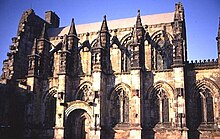Rosslyn Chapel
| Rosslyn Chapel | |
|---|---|
 |
|
| 55°51′19″N 3°09′37″W / 55.85528°N 3.16028°WCoordinates: 55°51′19″N 3°09′37″W / 55.85528°N 3.16028°W | |
| OS grid reference | NT275630 |
| Location | Roslin, Midlothian |
| Country | Scotland |
| Denomination | Scottish Episcopal Church |
| Previous denomination | Roman Catholic |
| Website | www |
| History | |
| Dedication | Saint Matthew |
| Architecture | |
| Status | Chapel |
| Functional status | Active |
| Heritage designation | Category A |
| Groundbreaking | 20 September 1456 |
| Administration | |
| Diocese | Edinburgh |
| Clergy | |
| Priest in charge | The Revd Dr Joe Roulston |
| Laity | |
| Director of music | John Cranston |
|
Listed Building – Category A
|
|
| Official name: Rosslyn Chapel (Episcopal), formerly Collegiate Church of St Matthew, including vaults, burial ground and boundary hills |
|
| Designated | 22 January 1971 |
| Reference no. | 13028 |
Rosslyn Chapel, formally known as the Collegiate Chapel of St Matthew, is a 15th-century chapel located at the village of Roslin, Midlothian, Scotland.
Rosslyn Chapel was founded on a small hill above Roslin Glen as a Catholic collegiate church (with between four and six ordained canons and two boy choristers) in the mid-15th century. The chapel was founded by William Sinclair, 1st Earl of Caithness of the Scoto-Norman Sinclair family. Rosslyn Chapel is the third Sinclair place of worship at Roslin, the first being in Roslin Castle and the second (whose crumbling buttresses can still be seen today) in what is now Roslin Cemetery.
The purpose of the college was to celebrate the Divine Office throughout the day and night and also to celebrate Mass for all the faithful departed, including the deceased members of the Sinclair family. During this period the rich heritage of plainsong (a single melodic line) or polyphony (vocal harmony) would be used to enrich the singing of the liturgy. An endowment was made that would pay for the upkeep of the priests and choristers in perpetuity and they also had parochial responsibilities.
After the Scottish Reformation (1560), Roman Catholic worship in the chapel was brought to an end, although the Sinclair family continued to be Roman Catholics until the early 18th century. From that time the chapel was closed to public worship until 1861, when it was opened again as a place of worship according to the rites of the Scottish Episcopal Church, a member church of the Anglican Communion.
It was reported in The Argus of Melbourne Australia that Rosslyn Chapel came under an alleged bombing attempt by a suffragette.
Since the late 1980s, the chapel has also featured in speculative theories concerning a connection of Freemasonry, the Knights Templar and the Holy Grail. It was prominently featured in the 2003 bestselling novel The Da Vinci Code and its 2006 film adaptation.
...
Wikipedia

